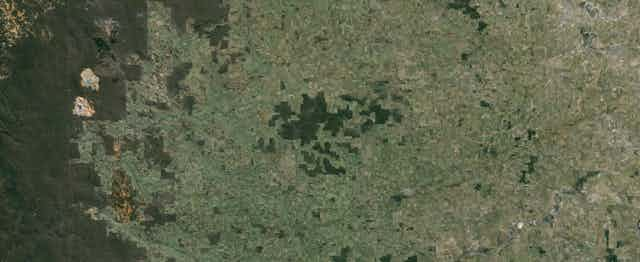Australia is renowned globally for its vast expanses of untouched wilderness. But for anyone who has travelled across its breadth, the myth of Australia’s pristine wilderness is quickly debunked as evidence of human impact spreads before the eye.
Most ecosystems have suffered huge losses. In a recent study, we looked at the magnitude of land clearing since European settlement. Some ecosystems have been devastated.
There are 75 major terrestrial ecosystems or vegetation communities in Australia, each of which are composed of hundreds of smaller communities of plants and animals. As you can see from the map below, many have been cleared extensively.

Six of these 75 terrestrial ecosystems have lost 50% or more of their original extent which, combined, originally added to almost a million square kilometres. The worst hit are some of the mallee ecosystems in southern Australia, suffering up to 97% loss.
The temperate eucalypt woodlands of south-east Australia previously covered more than a million square kilometres. Now there are less than half that, having been cleared for agriculture and urban development.
Among these areas are some of the most biodiverse woodland communities on Earth, including the critically endangered Box-Gum Grassy Woodland, which has been reduced to less than 10% of its pre-1750 extent.

The loss hasn’t been confined to trees. Temperate grasslands have lost 80%. Even the open woodland habitats across the north – which have a fraction of the people of the east and are considered the last great savannah wilderness on Earth – have lost 20-30% of their extent largely as a result of pastoral activities.
First cleared, then cut to pieces
But that’s not the worst of it.
As well as the declines in the extent of almost every vegetated ecosystem in Australia, most ecosystems are increasingly fragmented. That is, the ecosystem occurs in smaller and smaller patches surrounded by agriculture, urbanisation, and corridors such as roads and railways.
Many Australian vegetation communities now occur in small patches. Startlingly, one in five Australian vegetation communities have more than half of their remaining extent in patches smaller than 10 square kilometres. This has serious consequences for the species inhabiting these systems.

The brigalow forests and woodlands of Queensland contain the only remaining populations of a number of unique species, including the endemic Retro Slider, Brigalow Scaly-foot and Golden-tailed Gecko. Brigalow previously covered almost 100,000 square kilometres of inland Queensland – bigger than Tasmania.
Brigalow has been affected by the double jeopardy of high loss (87%) and high fragmentation. Two-thirds of its remaining extent is in patches smaller than 50 square kilometres.

In the far north, the Mahogany Glider, one of Australia’s most threatened tree-dwelling mammals, is dependent on lowland tropical rainforest for its survival.
Lowland rainforest is highly vulnerable to loss of small patches – half of its remaining extent consists of patches smaller than 15 square kilometres. The continuous erosion of small patches of rainforest will certainly lead to the extinction of the Mahogany Glider, as well as declines in and extinctions of many other species surviving in small patches around Australia.
Time for new way of thinking
Current environmental policy means we continue to degrade nature at a rapid pace. Clearing of remnant vegetation in Queensland alone nearly doubled from 520 square kilometres in 2012-13 to 950 square kilometres in 2013-14, and nearly quadrupled since 2009-10. The Queensland Labor government has vowed to reform land clearing laws that contributed to this increase.
Patches smaller than five hectares can be routinely cleared without permits. Small patches such as these are mostly ignored by conservation activities, and instead, policies in fragmented landscapes largely focus on keeping remaining large patches intact. This will not be enough to save some ecosystems.
Well over 1,100 square kilometres of remnant vegetation patches have been approved for clearing for High Value Agriculture in Queensland. On a single property in the north, almost 580 square kilometres was recently cleared to make way for high-value agriculture such as sorghum and soy beans.

These cleared ecosystems contained vulnerable and endangered birds such as the Red Goshawk. Satellite analysis has detected unexplained, possibly illegal, broadscale clearing of small vegetation patches in many parts of Queensland that are still mapped as regulated remnant. Much of this clearing is occurring in places where we identified high vulnerability to loss of small patches, such as the tropical rainforests in the far northeast of Australia.

Policies urgently need to change at state and federal levels. We need to stop the clearing of vegetation communities and fragments. For example, the arbitrary five hectare threshold for land clearing in Queensland needs to be re-evaluated. These thresholds should instead be tailored to each ecosystem.
Globally we need to stop thinking only about the total amount of vegetation loss and consider size and number of remaining fragments. This will be crucial for assessing the health of ecosystems and protecting remnants.
Since most remaining vegetation is on private land, landholders will need incentives to retain small patches, and developers will need a way of choosing between two patches to ensure economic growth and resource consumption needs can still be met.
The long-term consequences of policy inaction is the slow, inevitable decline of remaining vegetation communities, and further loss of the species dependent on them: a death by a thousand cuts.

